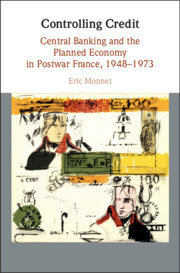Refine search
Actions for selected content:
26946 results in Economic history
Dedication
-
- Book:
- Controlling Credit
- Published online:
- 29 October 2018
- Print publication:
- 15 November 2018, pp v-vi
-
- Chapter
- Export citation

Controlling Credit
- Central Banking and the Planned Economy in Postwar France, 1948–1973
-
- Published online:
- 29 October 2018
- Print publication:
- 15 November 2018

Twentieth-Century South Africa
- A Developmental History
-
- Published online:
- 26 October 2018
- Print publication:
- 25 October 2018
1 - White-run South Africa as a Developmental State
-
- Book:
- Twentieth-Century South Africa
- Published online:
- 26 October 2018
- Print publication:
- 25 October 2018, pp 1-18
-
- Chapter
- Export citation
Contents
-
- Book:
- Twentieth-Century South Africa
- Published online:
- 26 October 2018
- Print publication:
- 25 October 2018, pp v-v
-
- Chapter
- Export citation
Index
-
- Book:
- Twentieth-Century South Africa
- Published online:
- 26 October 2018
- Print publication:
- 25 October 2018, pp 245-260
-
- Chapter
- Export citation
Bibliography
-
- Book:
- Twentieth-Century South Africa
- Published online:
- 26 October 2018
- Print publication:
- 25 October 2018, pp 222-244
-
- Chapter
- Export citation
8 - The Company Towns of the Vaal Triangle
-
- Book:
- Twentieth-Century South Africa
- Published online:
- 26 October 2018
- Print publication:
- 25 October 2018, pp 139-170
-
- Chapter
- Export citation
7 - Key Institutions
-
- Book:
- Twentieth-Century South Africa
- Published online:
- 26 October 2018
- Print publication:
- 25 October 2018, pp 122-138
-
- Chapter
- Export citation
Conclusion
-
- Book:
- Twentieth-Century South Africa
- Published online:
- 26 October 2018
- Print publication:
- 25 October 2018, pp 214-221
-
- Chapter
- Export citation
5 - The Impact of Apartheid, 1948–73
-
- Book:
- Twentieth-Century South Africa
- Published online:
- 26 October 2018
- Print publication:
- 25 October 2018, pp 82-102
-
- Chapter
- Export citation
4 - A (Near) Developmental State Forms, 1939–48
-
- Book:
- Twentieth-Century South Africa
- Published online:
- 26 October 2018
- Print publication:
- 25 October 2018, pp 62-81
-
- Chapter
- Export citation
9 - Energy and the Natural Environment
-
- Book:
- Twentieth-Century South Africa
- Published online:
- 26 October 2018
- Print publication:
- 25 October 2018, pp 171-190
-
- Chapter
- Export citation
Copyright page
-
- Book:
- Twentieth-Century South Africa
- Published online:
- 26 October 2018
- Print publication:
- 25 October 2018, pp iv-iv
-
- Chapter
- Export citation
3 - Industrial Development in South Africa up to the Second World War
-
- Book:
- Twentieth-Century South Africa
- Published online:
- 26 October 2018
- Print publication:
- 25 October 2018, pp 40-61
-
- Chapter
- Export citation
Tables
-
- Book:
- Twentieth-Century South Africa
- Published online:
- 26 October 2018
- Print publication:
- 25 October 2018, pp vii-vii
-
- Chapter
- Export citation
10 - Developmentalism Dismantled
-
- Book:
- Twentieth-Century South Africa
- Published online:
- 26 October 2018
- Print publication:
- 25 October 2018, pp 191-213
-
- Chapter
- Export citation
2 - The Conflicted Foundations of Industrial Policy
-
- Book:
- Twentieth-Century South Africa
- Published online:
- 26 October 2018
- Print publication:
- 25 October 2018, pp 19-39
-
- Chapter
- Export citation
Acknowledgements
-
- Book:
- Twentieth-Century South Africa
- Published online:
- 26 October 2018
- Print publication:
- 25 October 2018, pp viii-x
-
- Chapter
- Export citation
Figures and Maps
-
- Book:
- Twentieth-Century South Africa
- Published online:
- 26 October 2018
- Print publication:
- 25 October 2018, pp vi-vi
-
- Chapter
- Export citation
